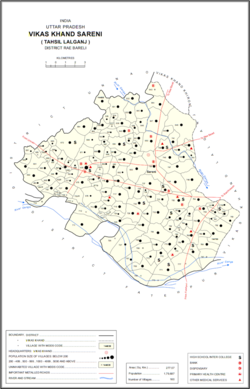Kahinjar
Kahinjar
Kahanjara, Kahanjar | |
|---|---|
Village | |
 Map showing Kahinjar (#633) in Sareni CD block | |
| Coordinates: 26°11′32″N 80°48′11″E / 26.192227°N 80.803154°E[1] | |
| Country | |
| State | Uttar Pradesh |
| District | Raebareli |
| Area | |
• Total | 2.258 km2 (0.872 sq mi) |
| Population (2011)[2] | |
• Total | 2,099 |
| • Density | 930/km2 (2,400/sq mi) |
| Languages | |
| • Official | Hindi |
| Time zone | UTC+5:30 (IST) |
| Vehicle registration | UP-35 |
Kahinjar is a village in Sareni block of Rae Bareli district, Uttar Pradesh, India.[2] It is located 20 km from Lalganj, the tehsil headquarters.[3] Kahinjar historically served as the headquarters of a mahal since at least the time of Akbar, before being merged into the pargana of Sareni under the Nawabs of Awadh.[4] As of 2011, Kahinjar has a population of 2,099 people, in 354 households.[2] It has one primary school and no healthcare facilities.[2] It belongs to the nyaya panchayat of Rasulpur.[5]
History
[edit]Kahinjar is the Kahanjara mentioned in the late-16th-century Ain-i-Akbari as one of the mahals in the sarkar of Lucknow.[4] It was held by the Bais Rajputs and paid a revenue of 818,472 dams to the imperial treasury and supplied the Mughal army with a force of 2,000 infantry and 100 cavalry.[6] It was later merged with three other mahals to form the pargana of Sareni under the Nawabs of Awadh.[4]
The 1951 census recorded Kahinjar as comprising 5 hamlets, with a total population of 727 people (392 male and 335 female), in 136 households and 119 physical houses.[7] The area of the village was given as 570 acres.[7] 35 residents were literate, all male.[7] The village was listed as belonging to the pargana of Sareni and the thana of Sareni.[7]
The 1961 census recorded Kahinjar as comprising 5 hamlets, with a total population of 830 people (439 male and 432 female), in 156 households and 141 physical houses.[8] The area of the village was given as 570 acres.[8]
The 1981 census recorded Kahinjar as having a population of 1,254 people, in 203 households, and having an area of 228.65 hectares.[3] The main staple foods were given as wheat and rice.[3]
The 1991 census recorded Kahinjar as having a total population of 1,481 people (720 male and 761 female), in 231 households and 231 physical houses.[5] The area of the village was listed as 228 hectares.[5] Members of the 0-6 age group numbered 282, or 19% of the total; this group was 53% male (149) and 47% female (133).[5] Members of scheduled castes made up 35% of the village's population, while no members of scheduled tribes were recorded.[5] The literacy rate of the village was 42% (382 men and 244 women).[5] 411 people were classified as main workers (327 men and 84 women), while 0 people were classified as marginal workers; the remaining 1,070 residents were non-workers.[5] The breakdown of main workers by employment category was as follows: 178 cultivators (i.e. people who owned or leased their own land); 207 agricultural labourers (i.e. people who worked someone else's land in return for payment); 0 workers in livestock, forestry, fishing, hunting, plantations, orchards, etc.; 0 in mining and quarrying; 2 household industry workers; 3 workers employed in other manufacturing, processing, service, and repair roles; 1 construction worker; 3 employed in trade and commerce; 0 employed in transport, storage, and communications; and 27 in other services.[5]
References
[edit]- ^ "Geographic Names Search WebApp". Search for "Kahinjar" here.
- ^ a b c d e "Census of India 2011: Uttar Pradesh District Census Handbook - Rae Bareli, Part A (Village and Town Directory)" (PDF). Census 2011 India. pp. 262–87. Retrieved 14 August 2021.
- ^ a b c Census 1981 Uttar Pradesh: District Census Handbook Part XIII-A: Village & Town Directory, District Rae Bareli (PDF). 1982. pp. 134–5. Retrieved 14 August 2021.
- ^ a b c Nevill, H.R. (1905). Rai Bareli: A Gazetteer, Being Volume XXXIX Of The District Gazetteers Of The United Provinces Of Agra And Oudh. Allahabad: Government Press. pp. 141–2, 223. Retrieved 14 August 2021.
- ^ a b c d e f g h Census 1991 Series-25 Uttar Pradesh Part-XII B Village & Townwise Primary Census Abstract District Census Handbook District Raebareli (PDF). 1992. pp. xxiv–xxviii, 158–9. Retrieved 22 October 2021.
- ^ Abu'l-Fazl ibn Mubarak; Jarrett, Henry Sullivan (translator) (1891). The Ain-i-Akbari. Calcutta: Asiatic Society of Bengal. p. 178. Retrieved 14 August 2021.
{{cite book}}:|first2=has generic name (help) - ^ a b c d Census of India, 1951: District Census Handbook Uttar Pradesh (42 - Rae Bareli District) (PDF). Allahabad. 1955. pp. 110–1. Retrieved 22 October 2021.
{{cite book}}: CS1 maint: location missing publisher (link) - ^ a b Census 1961: District Census Handbook, Uttar Pradesh (39 - Raebareli District) (PDF). Lucknow. 1965. pp. lxviii-lxix of section "Rae Bareli Tahsil". Retrieved 14 August 2021.
{{cite book}}: CS1 maint: location missing publisher (link)

